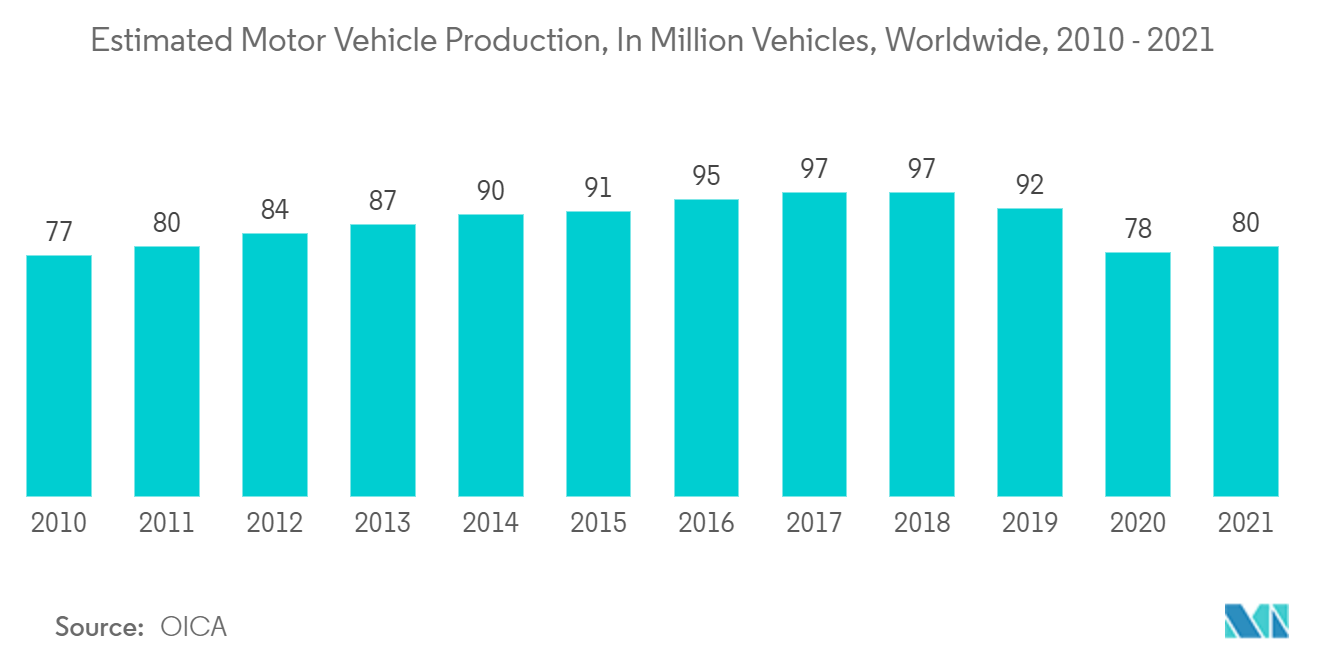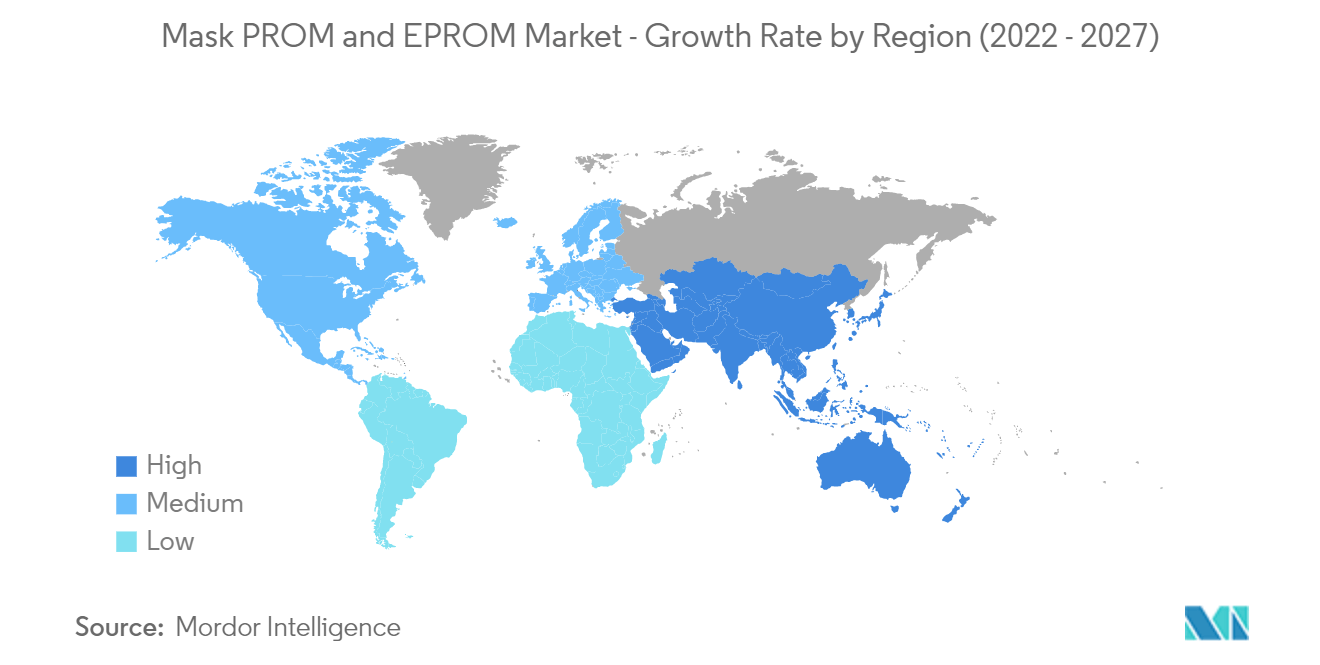Market Trends of Mask PROM and EPROM Industry
This section covers the major market trends shaping the Mask PROM & EPROM Market according to our research experts:
Increasing Trend of Usage of Microcontroller in Automobiles is Expected to Drive the Market's Growth
- Automotive microcontrollers are self-contained systems with their CPU, memory, and peripherals. The system makes use of an embedded chip that controls operations in autos. Microcontrollers are employed in the system since they are compact and have few components. The instructions of the microcontroller for desired functions in the automobile are saved in the Masked PROM and EPROM chip embedded in the IC of the controller. The use of various microcontrollers in-vehicle electronics, as well as other electronic control units, is expanding. AVR microcontrollers, 8051 microcontrollers, PIC microcontrollers, and other types of microcontrollers are commonly used in automobiles. These microcontrollers include an 8-bit or 16-bit microprocessor and a Mask PROM to operate.
- The EPROM's functions in the automobile industry include information storage, command execution, and communication to the various car parts, including the intake manifold. According to OICA, About 9.17 million automobiles were produced by the American auto industry in 2021, an increase from 8.82 million in 2020. The figures comprise light trucks, heavy vehicles, buses, coaches, and passenger automobiles. Such a huge increase in automotive production will drive the studied market.
- To meet the various demands of the customer and expand their presence in different regions, microcontroller firms are developing new products for the automotive industry. For instance, in April 2022, The E3 family of ARM-based automotive microcontrollers was released by Nanjing SemiDrive Technology Ltd. . Drive-by-wire chassis, brake control, BMS, ADAS/autonomous driving motion control, LCD instrumentation, HUD, and streaming media vision system are the targets of these. The X9 cockpit controller, the V9 ADAS and autonomous driving processor, and the G9 multi-domain networked vehicle gateway and security chip are already popular SemiDrive chips. The E3 series is a complement to these chips.
- With a growth in advanced driving assistance system (ADAS) technology, such as lane departure warning, automated emergency braking, adaptive cruise control, and blind spot detection systems, firms are developing the latest power memory products. For instance, in February 2021, Micron Technology, Inc. reported that it has begun sampling the industry's first automotive low-power DDR5 DRAM (LPDDR5) memory that is hardware-evaluated to meet the most stringent Automotive Safety Integrity Level (ASIL), ASIL D. The solution is based on the International Organization for Standardization (ISO) 26262 standard and is a component of Micron's new line of memory and storage devices aimed at the automotive functional safety market.
- In November 2021, FORESEE provided Automotive Memory Chips to Advance Automotive Intelligence R&D. Longsys has been rapidly growing its business in the market for vehicle storage. Its in-vehicle storage solutions can be used in various situations, including high-speed rail systems, public transit, and factory- and aftermarket-installed autos. AEC-Q100 certification has been gained by Automotive eMMC, a product created by FORESEE, a technological storage brand of Longsys. AEC-Q100 is a verification standard established by the American Automotive Electronics Council (AEC) in 2020. This standard guarantees higher-quality electronic components and the packaged ICs in the standard series have undergone this verification.
- Automotive microcontrollers increasingly use high-performance RISC CPUs rather than older CISC chips. The ability to execute an instruction in a single clock cycle and the fact that RISC processors do not employ microcode to decode instructions but are hardwired using Mask PROM and EPROM. Mask PROM and EPROM for program storage are the common microcontroller memory types established in automotive systems. But the current trend of Flash EEPROM is gradually becoming more affordable, it will eventually replace the Mask PROM and PROM and become the preferred memory solution.

Asia-Pacific is Expected to Witness a Significant Market Growth
- The rising need for advanced features, increasing penetration of IoT technology, and the emergence of data-centric applications in numerous industry verticals in the APAC region are the major factors propelling the Mask PROM and EPROM market growth in the region. Moreover, government organizations are collaborating with Enterprises and SMBs to establish an IoT-enabled ecosystem in India. According to the ASSOCHAM, in a hyper-connected India, IoT has the potential to reach an estimated 2 billion connections, unlocking revenues of USD 11.1 billion by 2022. This is indirectly creating a growth opportunity for Mask PROM and EPROM market in the region because these types of memories are used in the microcontrollers in IoT Devices.
- Highly autonomous vehicles (AVs) are becoming more common on our roadways. Trials around the Asia Pacific have shown promise, with some countries being more prepared for AV adoption than others. For instance, According to Huawei, by 2030, autonomous vehicles will account for 20% of new vehicle sales in China and 10% globally., and China's EV penetration is expected to increase by 25% by 2025. High functional microcontrollers are used in these advanced driver-assistance systems (ADAS) with software commands for which the demand for Mask PROM and EPROM in this region will increase.
- With the presence of emerging economies like India and China, the APAC region contributes to having the highest market share in consumer electronics. Smartphones, laptops, tablets, and smartwatches. Emerging nations, such as India, have been witnessing a decline in data costs since 2013. This has resulted in an increase in the number of smartphone users. According to ASSOCHAM, the number of smartphone users in India is anticipated to double from around 468 million users in 2017 to 859 million by 2022.The market for Mask PROM and EPROM is predicted to expand rapidly in the future as the region's population demands more wireless and advanced consumer gadgets. The presence of a significant number of Chinese semiconductor makers is largely responsible for the region's dominance.
- The Government of India is concentrating on its crucial goal of creating the overall semiconductor ecosystem and making sure that it will catalyze India's fast-increasing electronics manufacturing and innovation ecosystem, according to the Ministry of Electronics and IT. The Union Cabinet presided over by the Hon'ble Prime Minister approved the Semiconductor India program (SIP) in December 2021, providing a total outlay of INR 76,000 crore for the growth of the semiconductor and display manufacturing ecosystem in our nation. This gave the vision of Atma Nirbhar Bharat in electronics and semiconductors additional momentum.
- Further, all the big Mask PROM and EPROM manufacturers are increasing their presence in the APAC region to increase their market shares, predicting the region's growth. For example, NXP Semiconductors NV, a global player in Mask memory, has strengthened its presence in Asia by establishing Singapore as its global headquarters for standard products and operations.

